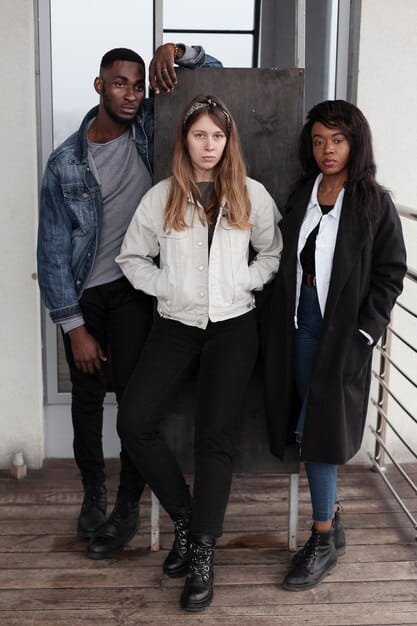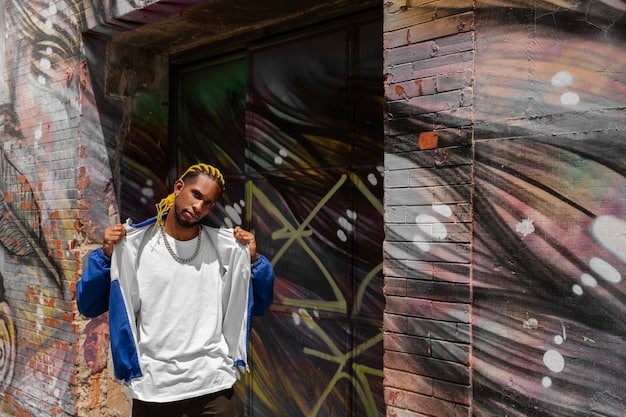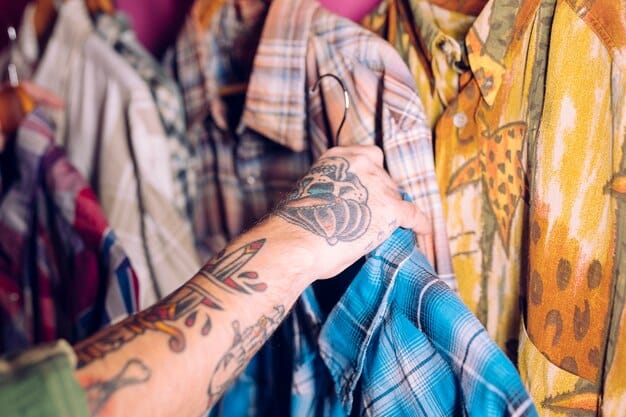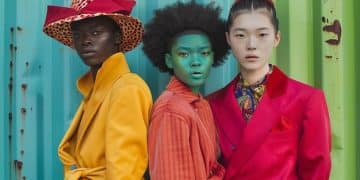Gen Z’s Fashion Choices: Individuality and Self-Expression Drive Style

Gen Z’s fashion choices are uniquely characterized by a profound emphasis on individuality and self-expression, fostering diverse trends that challenge traditional style norms and embrace authenticity over conformity.
In a world increasingly defined by digital fluidity and social consciousness, Gen Z’s fashion choices: how individuality and self-expression drive their style stand out as a vibrant testament to personal identity. This generation, often heralded as pioneers of authenticity, views clothing not merely as attire but as a powerful medium for storytelling and connection, reshaping the very landscape of contemporary trends.
The Digital Canvas: Fashion Influences in the Age of Social Media
Exploring the profound impact of social media, this section delves into how platforms like TikTok and Instagram have transformed the fashion landscape for Gen Z, making individuality a key currency. It’s no longer just about following trends; it’s about setting them, often in highly personalized ways that resonate with niche communities.
Social media has undeniably revolutionized how Gen Z engages with and perceives fashion. Unlike previous generations who relied heavily on magazines, runway shows, or brick-and-mortar stores for inspiration, Gen Z navigates a constant stream of digital content. This real-time accessibility to global styles and micro-trends means their aesthetic evolution is rapid and multifaceted. They are not merely consumers but active participants in the fashion dialogue, curating their feeds and contributing to the visual lexicon of modern style. The democratization of fashion, powered by these platforms, allows for an unprecedented level of experimentation and self-discovery.
From Niche Aesthetics to Viral Trends
The digital realm facilitates the rapid rise and fall of “micro-trends” and “aesthetic cores,” from Cottagecore to Dark Academia, each offering a distinct visual identity that Gen Z can adopt, adapt, or reject. These trends often originate from specific online communities before spilling over into the mainstream, highlighting the power of collective self-expression. For example, a vintage-inspired piece seen on a TikTok influencer can quickly become a sought-after item, illustrating the tangible impact of digital influence. This fluid exchange of ideas cultivates an environment where personal style can genuinely flourish, unbound by traditional fashion calendars or gatekeepers.
- TikTok’s Algorithmic Influence: The “For You” page customizes content, exposing users to hyper-specific fashion trends and fostering niche communities.
- Instagram’s Visual Storytelling: A platform for curated aesthetics and aspirational outfits, driving visual inspiration and brand discovery.
- YouTube’s Hauls and Lookbooks: Influencers showcase personal style, thrift finds, and styling tips, offering practical guidance for self-expression.
Beyond mere consumption, Gen Z actively leverages these platforms for creative self-expression. They share their outfit-of-the-day (OOTD) videos, participate in style challenges, and engage in discussions about sustainable fashion or ethical consumption. This interactive approach transforms fashion from a passive pursuit into an active, communal experience. Brands, too, have adapted, engaging with influencers and creators to reach this discerning demographic, often prioritizing authenticity and relatable content over polished, traditional advertising. The feedback loop between creators and consumers fosters a dynamic environment where fashion is continually evolving, driven by individual voices.
In essence, social media acts as both a mirror and a magnifier for Gen Z’s fashion inclinations. It reflects their desire for authenticity, magnifies their individual style choices, and provides a fertile ground for the seeds of self-expression to bloom into global fashion phenomena. This ecosystem of digital influence is central to understanding why individuality and self-expression drive their style, pushing boundaries and redefining what it means to be fashionable in the 21st century.
Sustainability and Ethics: More Than Just a Trend, a Lifestyle
This section explores Gen Z’s commitment to sustainable and ethical fashion practices, highlighting how their values translate into their purchasing and styling choices. It’s a reflection of a generation acutely aware of global issues.
Gen Z’s approach to fashion transcends mere aesthetics; it is deeply intertwined with their ethical and environmental consciousness. Unlike previous generations, this demographic has grown up with pervasive awareness of climate change, social injustice, and consumerism’s global impact. Consequently, their fashion choices are often a direct manifestation of their values, leading to a significant shift towards more sustainable and ethical consumption patterns. This isn’t just about following a fleeting trend; for many, it’s a fundamental aspect of their lifestyle and identity. They often prioritize transparency, seeking out brands that align with their principles, and rejecting those perceived as exploitative or environmentally damaging.
The Rise of Thrift and Second-Hand Shopping
One of the most prominent ways Gen Z demonstrates their commitment to sustainability is through their embrace of second-hand and vintage clothing. Thrifting, once associated with necessity, has become a badge of honor and a celebrated avenue for developing unique personal style. Platforms like Depop and Poshmark, alongside traditional thrift stores, thrive because they resonate with Gen Z’s desire for unique pieces while reducing fashion waste. This movement not only offers an affordable alternative to fast fashion but also allows individuals to express their creativity by repurposing and restyling pre-loved garments. The joy of finding a one-of-a-kind item and giving it a new life is a powerful motivator.
- Circular Fashion Economy: Contributing to reducing waste and extending the life cycle of garments through reselling and thrifting.
- Unique Finds and Personalization: Opportunity to discover distinctive pieces that stand out from mass-produced clothing.
- Cost-Effectiveness: A more affordable way to access diverse styles and experiment with fashion without breaking the bank.

Furthermore, Gen Z is highly critical of “fast fashion” brands, pressuring them to adopt more responsible practices. They are willing to invest in higher-quality, durable items from ethical brands, even if it means fewer purchases overall. This conscious consumption extends to understanding supply chains, labor practices, and material sourcing. They scrutinize labels, research brand values, and advocate for greater accountability within the industry. This discerning approach indicates a maturity in their consumer habits, showcasing a generation that understands the power of their purchasing decisions. Their advocacy for change often plays out on social media, where they share information, expose unethical practices, and celebrate brands that embody their values.
Ultimately, for Gen Z, fashion is a political act. It’s a statement about who they are, what they believe in, and the kind of world they envision. By actively choosing sustainable and ethical options, they are not only curating personal style but also contributing to a broader movement for a more responsible and equitable fashion industry. This profound intersection of personal expression and deeply held values is a defining characteristic of Gen Z’s fashion choices.
Gender Fluidity and Blurring Lines: Redefining Traditional Norms
This section explores how Gen Z is dismantling traditional gender norms in fashion, embracing fluidity, and advocating for styles that transcend binary definitions. This openness fosters a more inclusive and diverse sartorial landscape.
Gen Z stands at the forefront of a cultural shift that is radically redefining gender norms, and fashion is an incredibly visual manifestation of this evolution. For many within this generation, clothing is not inherently masculine or feminine; instead, it is a tool for personal expression that should be accessible to all, regardless of gender identity. This perspective naturally leads to a blurring of traditional fashion lines, where garments are increasingly seen as gender-neutral, allowing for unprecedented freedom in style. The rigid categories of societal norms are being dismantled, piece by piece, as Gen Z champions a more inclusive aesthetic. They challenge the idea that certain colors, silhouettes, or fabrics belong exclusively to one gender, instead choosing what resonates with their individual sense of self.
The rise of “genderless” or “unisex” collections from both mainstream and independent brands is a direct response to this generational demand. Hoodies, oversized blazers, wide-leg trousers, and even traditionally feminine accessories are being embraced by all genders, transcending their historical connotations. This shift reflects a deeper societal recognition of diverse identities, where clothing serves as an extension of one’s authentic self, rather than a prescribed uniform based on external expectations. It’s a powerful statement of acceptance and self-affirmation that reverberates throughout the fashion industry.
Challenging Binary Fashion
Gen Z’s willingness to experiment with clothing that traditionally belongs to the opposite gender is a testament to their fluid approach. Dresses on men, suits on women, and makeup as a form of self-expression for everyone are becoming more common sights, both online and offline. This cross-pollination of styles encourages a more creative and less restrictive approach to dressing. The freedom to wear what feels right, irrespective of societal expectations, is a cornerstone of this generation’s sartorial philosophy.
- Breaking Stereotypes: Challenging the notion that certain clothing items are exclusively for one gender.
- Personal Authenticity: Encouraging individuals to wear what truly expresses their inner self, rather than conforming to external norms.
- Inclusive Collections: Demanding and supporting brands that offer gender-neutral designs and cater to diverse body types and identities.
This exploration of gender fluidity in fashion is inherently tied to Gen Z’s broader embrace of identity politics and self-actualization. They understand that what one wears can be a profound visual declaration of who they are and how they wish to be perceived. By dismantling the binary, they are not only creating more innovative and diverse fashion but also contributing to a more accepting and understanding society. This bold approach to dressing underscores how individuality and self-expression drive their style, setting a precedent for future generations and reshaping the very concept of fashion. Their influence extends beyond mere trends; it contributes to a wider cultural shift towards greater inclusivity.
Nostalgia and Reimagination: The Vintage Revival
This section looks at Gen Z’s fascination with vintage and retro aesthetics, exploring how they reinterpret past trends through a contemporary lens. It’s not just replication, but a creative fusion.
Gen Z’s fashion sensibilities are not solely focused on the future; they often look to the past, embracing a deep appreciation for vintage and retro aesthetics. This fascination is more than a simple rehash of old trends; it’s a dynamic process of reimagination, where past styles are filtered through a contemporary lens, infused with personal touches, and given new life. This generation finds value in the unique narratives and craftsmanship often associated with older garments, seeing them as distinct expressions of style in a world prone to mass production. It’s an ode to durability, a rejection of disposability, and a creative challenge to make something old feel new again.
The allure of vintage lies in its uniqueness and perceived authenticity. In an era where highly curated digital personas are prevalent, a piece of clothing with a history offers a tangible connection to something real and distinct. Whether it’s a perfectly worn-in band tee from the 80s, a structured blazer from the 90s, or a vibrant print from the 70s, these items allow Gen Z to curate wardrobes that reflect their individual stories, rather than simply adopting homogeneous, current trends. It’s an anti-trend approach within a trend.
The Art of Upcycling and Customization
Beyond simply wearing vintage, Gen Z is actively engaged in upcycling and customizing old garments. This creative process allows them to personalize pieces, transforming them into entirely new expressions of their style. Dyeing, cropping, embroidering, and adding embellishments turn generic items into bespoke creations. This DIY ethos not only supports sustainability but also amplifies the individual’s unique aesthetic vision. The satisfaction of transforming a forgotten item into a cherished personal piece is a powerful driver for this creative cohort.
- Historical Narratives: Each vintage piece carries a story, adding depth and uniqueness to an outfit.
- Anti-Fast Fashion Statement: Opting for pre-loved items as a conscious choice against overconsumption and mass production.
- Creative Personalization: The ability to modify and adapt vintage clothing to fit modern aesthetics and individual tastes.

The prevalence of online communities dedicated to vintage fashion, where users share their finds, styling tips, and customization projects, further fuels this trend. It creates a space for collective inspiration and reinforces the idea that true style is often discovered rather than bought new. This blend of nostalgic reverence and contemporary creativity ensures that Gen Z’s fashion choices continually break free from conventional molds. Their ability to fuse elements from disparate eras into cohesive, personal statements truly highlights how individuality and self-expression drive their style, creating a rich tapestry of sartorial narratives.
Comfort and Functionality: The Rise of Athleisure and Loungewear
This section examines how comfort and functionality have become paramount for Gen Z fashion, leading to the ubiquity of athleisure and elevated loungewear. It’s about combining ease with aesthetic appeal.
In a world that increasingly values comfort and practicality, Gen Z’s fashion choices reflect a profound shift towards styles that prioritize ease without sacrificing aesthetic appeal. The ubiquitous rise of athleisure and elevated loungewear is a testament to this preference, demonstrating that for this generation, clothing needs to seamlessly integrate into dynamic lifestyles. Whether working from home, pursuing hobbies, or socializing, clothes must be versatile and comfortable enough to facilitate diverse activities throughout the day. This isn’t just about laziness; it’s a conscious decision to choose garments that support well-being and allow for unencumbered movement and expression.
The pandemic undoubtedly accelerated the adoption of comfortable wear, but Gen Z’s embrace of athleisure as everyday attire predates it. They have normalised wearing hoodies, sweatpants, leggings, and sneakers in a variety of settings, deftly styling them to look chic and intentional rather than purely utilitarian. This ability to elevate casual pieces speaks to their innate creativity and their desire for clothing that genuinely serves their needs. It reflects an active, engaged lifestyle where flexibility is key, and an aesthetic where function meets form.
Bridging the Gap Between Casual and Chic
Gen Z has mastered the art of bridging the gap between casual and chic. They pair structured blazers with joggers, style oversized hoodies with tailored trousers, and accessorize sneakers with elevated jewelry. This eclectic mix creates a look that is polished yet relaxed, demonstrating that comfort does not necessarily equate to sloppiness. This strategic blending allows them to move effortlessly from casual outings to more formal settings, all while maintaining a strong sense of personal style.
- Versatility for Diverse Lifestyles: Clothing adapts to a hybrid lifestyle of work, leisure, and social activities.
- Focus on Wellbeing: Prioritizing comfort supports mental and physical well-being throughout daily routines.
- Smart Styling: Combining comfortable pieces with tailored or unexpected elements to create elevated, unique looks.
The comfort-first approach extends beyond just athleisure into all aspects of their wardrobe. Fabrics are chosen for their softness and stretch, silhouettes are often relaxed, and layering is key for adaptability. This practical perspective on fashion underlines how individuality and self-expression drive their style, as they curate wardrobes that truly serve their multifaceted lives. It also challenges traditional notions of what “dressing up” entails, demonstrating that personal confidence and comfort are the ultimate style accelerators. For Gen Z, fashion is about feeling good and living authentically, and their clothing choices reflect this philosophy down to the last comfortable stitch.
Identity and Advocacy: Fashion as a Statement
This section looks at how Gen Z uses fashion as a powerful tool for social and political commentary, expressing their identities and advocating for causes they believe in. It’s about personal style with purpose.
For Gen Z, fashion is rarely just about aesthetics; it often serves as a potent vehicle for expressing their deeply held beliefs, personal identities, and advocating for social and political causes. This generation is highly engaged with issues like climate justice, LGBTQ+ rights, racial equality, and mental health, and their clothing choices frequently become visual declarations of their stances. They understand that what one wears can be a powerful non-verbal form of communication, capable of conveying solidarity, defiance, or support. This transforms personal style into a form of activism, allowing them to participate in cultural conversations through their wardrobes.
This intentionality in dressing is evident in their embrace of graphic tees with political slogans, clothing made by minority-owned businesses, or accessories that symbolize specific movements. They are not afraid to use their bodies as canvases for their convictions, transforming everyday outfits into powerful statements. This aligns with their broader digital savviness, where online advocacy seamlessly integrates with their offline presence, creating a cohesive narrative of personal values. They want their fashion choices to resonate with their worldview.
Supporting Values Through Consumerism
Gen Z’s commitment to identity and advocacy is also reflected in their purchasing habits. They actively seek out and support brands that align with their values, prioritizing those that are transparent, ethically sound, and genuinely committed to social change. Conversely, they are quick to call out brands that engage in “woke-washing” or whose practices contradict their stated values, leveraging social media to hold companies accountable. This discerning consumer behavior means that every purchase can be a vote for the kind of world they wish to see.
- Visual Protests and Messages: Using apparel to display political, social, or environmental messages clearly.
- Brand Alignment: Supporting brands that authentically demonstrate social responsibility and inclusivity.
- Community Building: Fashion choices serve as identifiers, creating bonds within like-minded communities and movements.
Whether through wearing vintage to promote sustainability, opting for gender-neutral silhouettes to champion fluidity, or sporting apparel that supports a specific cause, every fashion choice is imbued with meaning. This intersection of personal identity and public advocacy underscores how profoundly individuality and self-expression drive their style. For Gen Z, fashion is a dynamic and essential component of their identity, a platform for their voices, and a testament to their unwavering commitment to shaping a more just and inclusive world. It’s a style with a clear purpose, reflective of a conscious generation.
The “Core” Culture: Hyper-Specific Aesthetics and Self-Styling
This section delves into the rise of “core” aesthetics (e.g., Cottagecore, Dark Academia, Kidcore), exploring how Gen Z gravitates towards highly specific and immersive style communities for self-expression.
The rise of “core” culture—hyper-specific aesthetic communities like Cottagecore, Dark Academia, Gothcore, Kawaii, or Kidcore—is a defining characteristic of Gen Z’s approach to fashion. These aesthetics are more than just fleeting trends; they are immersive subcultures, complete with their own visual language, music, media, and often, philosophies. For Gen Z, adopting a “core” is a powerful avenue for self-expression, allowing them to delve deep into a specific visual identity that resonates with their inner world. It’s a way to refine and articulate their individuality within a curated, like-minded community, challenging the notion of a single overarching trend.
Each “core” offers a distinct narrative and set of stylistic parameters, providing a framework within which individuals can express themselves creatively. For example, Cottagecore celebrates an idealized rural life with flowy dresses, floral prints, and natural fabrics, while Dark Academia embraces intellectual pursuits with tweed, tailored silhouettes, and vintage-inspired pieces. These aesthetics provide a sense of belonging and allow individuals to connect with others who share similar interests, fostering strong online communities where style inspiration is abundant.
DIY and Personal Interpretation
While “core” aesthetics have defined stylistic elements, Gen Z rarely adopts them wholesale without personal interpretation. Instead, individuals often blend elements from different “cores” or add their own unique twists, resulting in hybrid styles that are entirely their own. This DIY mentality, combined with the accessibility of platforms like TikTok for showcasing personal looks, encourages a continuous evolution of these aesthetics. It’s about personal exploration rather than strict adherence, allowing for maximum creativity.
- Community and Belonging: Finding others who share similar aesthetic preferences and passions.
- Creative Exploration: Deep diving into specific themes and visual languages for comprehensive self-expression.
- Hybridization of Styles: Combining elements from various “cores” or adding personal touches to create unique, personalized looks.
This affinity for hyper-specific aesthetics underscores how profoundly individuality and self-expression drive their style. It’s a move away from mass-market trends towards more personalized, niche forms of identification. By participating in “core” culture, Gen Z is not just dressing up; they are constructing complex visual identities that reflect their interests, values, and imaginative worlds. This granular approach to style, driven by a desire for authentic self-representation, means that the fashion landscape is constantly diversifying, fueled by the collective creativity of a generation committed to defining itself on its own terms.
| Key Aspect | Brief Description |
|---|---|
| 📱 Digital Influence | Social media platforms democratize fashion, fostering micro-trends and personal style curation. |
| ♻️ Sustainability Push | Strong preference for thrift, second-hand, and ethical brands, rejecting fast fashion. |
| 🚻 Gender Fluidity | Challenging traditional gender norms, embracing unisex and fluid styles for ultimate expression. |
| 🎨 Core Aesthetics | Gravitation towards highly specific aesthetic subcultures for distinct identity and community. |
Frequently Asked Questions About Gen Z Fashion
Gen Z’s fashion choices are predominantly driven by a strong desire for individuality and authentic self-expression. They view clothing as a crucial medium to communicate their personal identity, values, and belonging, often rejecting mainstream trends in favor of unique, curated styles.
Social media platforms like TikTok and Instagram significantly influence Gen Z’s style by democratizing fashion. They expose users to diverse micro-trends, niche aesthetics, and global styles, fostering a dynamic environment where inspiration is shared, and personal styles are constantly evolving and showcased.
Yes, sustainability is a critical factor. Gen Z often prioritizes ethical and environmentally friendly practices, leading to a strong inclination towards thrift shopping, second-hand clothing, and supporting brands with transparent supply chains, actively rejecting the fast fashion model.
Absolutely. Gen Z is at the forefront of challenging traditional gender norms in fashion. They frequently embrace gender-neutral clothing, blur the lines between historically masculine and feminine attire, and advocate for styles that prioritize individual comfort and expression over outdated societal expectations.
Vintage clothing appeals to Gen Z due to its uniqueness, sustainability, and the opportunity for creative personalization. It allows them to develop distinct, one-of-a-kind styles, reducing waste and providing a connection to history, transforming old pieces into fresh, personal expressions of their identity.
Conclusion
Gen Z’s impact on fashion is undeniable, marking a shift from uniform trends to kaleidoscopic self-expression. Their choices are a vibrant blend of digital influence, social consciousness, and a deep-seated desire for authenticity. By prioritizing individuality, sustainability, gender fluidity, and ethical practices, this generation isn’t just dictating what’s “in fashion”; they are actively reshaping the industry’s values and future direction. Their style is a powerful testament to the idea that clothing is more than fabric and thread—it’s a narrative, a statement, and a true reflection of the multifaceted human spirit.





